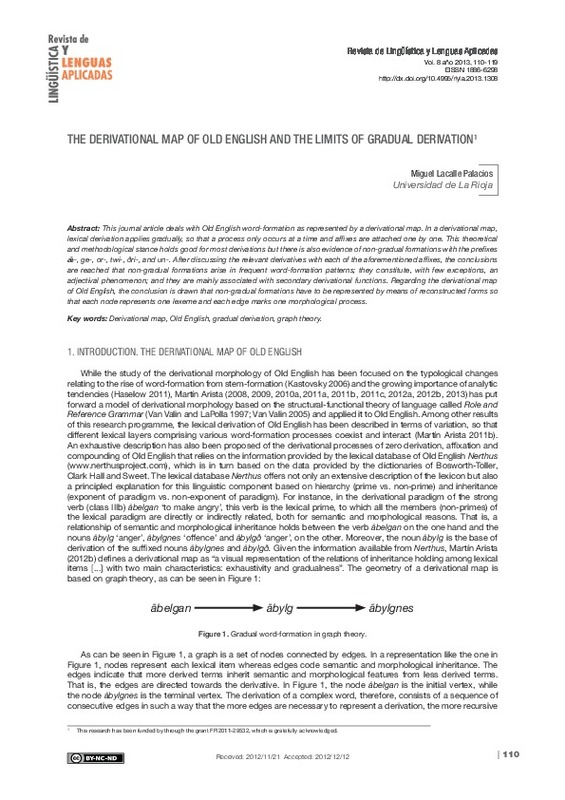JavaScript is disabled for your browser. Some features of this site may not work without it.
Buscar en RiuNet
Listar
Mi cuenta
Estadísticas
Ayuda RiuNet
Admin. UPV
The derivational map of Old English and the limits of gradual derivation
Mostrar el registro sencillo del ítem
Ficheros en el ítem
| dc.contributor.author | Lacalle Palacios, Miguel
|
es_ES |
| dc.date.accessioned | 2013-07-23T11:46:47Z | |
| dc.date.available | 2013-07-23T11:46:47Z | |
| dc.date.issued | 2013-07 | |
| dc.identifier.issn | 1886-2438 | |
| dc.identifier.uri | http://hdl.handle.net/10251/31325 | |
| dc.description.abstract | [EN] This journal article deals with Old English word-formation as represented by a derivational map. In a derivational map, lexical derivation applies gradually, so that a process only occurs at a time and affixes are attached one by one. This theoretical and methodological stance holds good for most derivations but there is also evidence of non-gradual formations with the prefixes ¿-, ge-, or-, twi-, ¿ri-, and un-. After discussing the relevant derivatives with each of the aforementioned affixes, the conclusions are reached that non-gradual formations arise in frequent word-formation patterns; they constitute, with few exceptions, an adjectival phenomenon; and they are mainly associated with secondary derivational functions. Regarding the derivational map of Old English, the conclusion is drawn that non-gradual formations have to be represented by means of reconstructed forms so that each node represents one lexeme and each edge marks one morphological process. | es_ES |
| dc.description.sponsorship | This research has been funded by through the grant FFI2011-29532, which is gratefully acknowledged. | |
| dc.language | Inglés | es_ES |
| dc.publisher | Editorial Universitat Politècnica de València | |
| dc.relation.ispartof | Revista de Lingüística y Lenguas Aplicadas | |
| dc.rights | Reserva de todos los derechos | es_ES |
| dc.subject | Derivational map | es_ES |
| dc.subject | Old English | es_ES |
| dc.subject | Gradual derivation | es_ES |
| dc.subject | Graph theory | es_ES |
| dc.title | The derivational map of Old English and the limits of gradual derivation | es_ES |
| dc.type | Artículo | es_ES |
| dc.date.updated | 2013-07-23T10:22:31Z | |
| dc.identifier.doi | 10.4995/rlyla.2013.1308 | |
| dc.relation.projectID | info:eu-repo/grantAgreement/MICINN//FFI2011-29532/ES/POLOS SEMANTICOS EN EL LEXICO DEL INGLES ANTIGUO. CONSTRUCCION DEL SIGNIFICADO, PRIMITIVOS SEMANTICOS Y FORMACION DE PALABRAS/ | |
| dc.rights.accessRights | Abierto | es_ES |
| dc.description.bibliographicCitation | Lacalle Palacios, M. (2013). The derivational map of Old English and the limits of gradual derivation. Revista de Lingüística y Lenguas Aplicadas. 8(1):110-119. https://doi.org/10.4995/rlyla.2013.1308 | es_ES |
| dc.description.accrualMethod | SWORD | es_ES |
| dc.relation.publisherversion | https://doi.org/10.4995/rlyla.2013.1308 | es_ES |
| dc.description.upvformatpinicio | 110 | es_ES |
| dc.description.upvformatpfin | 119 | es_ES |
| dc.description.volume | 8 | |
| dc.description.issue | 1 | |
| dc.identifier.eissn | 1886-6298 | |
| dc.contributor.funder | Ministerio de Ciencia e Innovación | |
| dc.description.references | Beard, R. and Volpe, M. (2005). "Lexeme-Morpheme Base Morphology", in P. Stekauer and R. Lieber (eds.), Handbook of Word-Formation. Dordrecht: Springer, 189-205. http://dx.doi.org/10.1007/1-4020-3596-9_8 | es_ES |
| dc.description.references | Bosworth, J. and T. N. Toller. 1973 (1898). An Anglo-Saxon Dictionary. Oxford: Oxford University Press. | es_ES |
| dc.description.references | Clark Hall, J. R. 1996 (1896). A Concise Anglo-Saxon Dictionary. Toronto: University of Toronto Press. | es_ES |
| dc.description.references | Haselow, A. (2011). Typological Changes in the Lexicon. Berlin: Mouton de Gruyter. Kastovsky, D. (2006). "Typological Changes in Derivational Morphology", in A. van Kemenade and B. Los (eds.), The Handbook of The History of English. Oxford: Blackwell, 151-177. | es_ES |
| dc.description.references | Martín Arista, J. (2008). "Unification and separation in a functional theory of morphology", in R. Van Valin (ed.), Investigations of the Syntax-Semantics- Pragmatics Interface. Amsterdam: John Benjamins, 119-145. | es_ES |
| dc.description.references | Martín Arista, J. (2009). "A Typology of Morphological Constructions", in C. Butler and J. Martín Arista (eds.), Deconstructing Constructions. Amsterdam: John Benjamins, 85-115. | es_ES |
| dc.description.references | Martín Arista, J. (2010a). "Lexical negation in Old English", NOWELE-North-Western European Language Evolution 60/61: 89-108. | es_ES |
| dc.description.references | Martín Arista, J. (2010b). "OE strong verbs derived from strong verbs", SKASE Journal of Theoretical Linguistics 7: 36-56. | es_ES |
| dc.description.references | Martín Arista, J. (2011a). "Projections and Constructions in Functional Morphology. The Case of Old English HRĒOW", Language and Linguistics 12/2: 393-425. | es_ES |
| dc.description.references | Martín Arista, J. (2011b). "Adjective formation and lexical layers in Old English", English Studies 92/3: 323-344. http://dx.doi.org/10.1080/0013838X.2011.564776 | es_ES |
| dc.description.references | Martín Arista, J. (2011c). "Morphological relatedness and zero alternation in Old English", in P. Guerrero Medina (ed.), Morphosyntactic Alternations in English. London: Equinox, 339-362. | es_ES |
| dc.description.references | Martín Arista, J. (Forthcoming-a). "The Old English Prefix Ge-: A Panchronic Reappraisal", Australian Journal of Linguistics. | es_ES |
| dc.description.references | Martín Arista, J. (Forthcoming-b). "Lexical database, derivational map and 3D representation", Revista Española de Lingüística Aplicada. | es_ES |
| dc.description.references | Martín Arista, J. (Forthcoming-c). "Recursivity, derivational depth and the search for Old English lexical primes", Studia Neophilologica. | es_ES |
| dc.description.references | Martín Arista, J. (Forthcoming-d). "Noun layers in Old English". Pounder, A. (2000). Processes and Paradigms in Word-Formation Morphology. Berlin: Mouton de Gruyter. | es_ES |
| dc.description.references | Sweet, H. 1976 (1896). The Student's Dictionary of Anglo-Saxon. Cambridge: Cambridge University Press. | es_ES |
| dc.description.references | Van Valin, R. (2005). Exploring the Syntax-Semantics Interface. Cambridge: Cambridge University Press. http://dx.doi.org/10.1017/CBO9780511610578 | es_ES |
| dc.description.references | Van Valin, R. and LaPolla, R. (1997). Syntax: Structure, meaning and function. Cambridge: Cambridge University Press. http://dx.doi.org/10.1017/CBO9781139166799 | es_ES |








